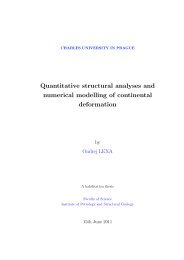Interpreting SrÅNd isotopic data from magmatic and metamorphic ...
Interpreting SrÅNd isotopic data from magmatic and metamorphic ...
Interpreting SrÅNd isotopic data from magmatic and metamorphic ...
Create successful ePaper yourself
Turn your PDF publications into a flip-book with our unique Google optimized e-Paper software.
Vojtěch Janoušek:<br />
<strong>Interpreting</strong> Sr–Nd <strong>isotopic</strong> <strong>data</strong>: numerical recipes<br />
It is apparent <strong>from</strong> [2.1] <strong>and</strong> Fig. 3–1 that a corresponds to the initial ratio of the whole cogenetic suite<br />
<strong>and</strong> the slope b of the isochron is expressed as:<br />
Giving a formula for isochron age:<br />
The isochrons are usually fitted using<br />
software given in Tab. 3–1. The<br />
algorithm utilizes weighted linear<br />
regression <strong>and</strong> follows York (1969).<br />
λt<br />
( e −1)<br />
b = tgα =<br />
[3.2]<br />
1<br />
t = ln b +<br />
λ<br />
( 1)<br />
Isochron<br />
Provost (1990) France Pascal<br />
IsoPlot Ludwig (1993) USA QuickBasic<br />
[3.3]<br />
Exercise 3-1<br />
Table 3-1: Software used for geochronological calculations<br />
[ISOCHRON.EXE]<br />
The Rb–Sr <strong>isotopic</strong> composition of the Serra do Acari granite <strong>from</strong> Pará, Brazil, was determined by Xafi da<br />
Silva et al. (1985). We will use this granite as a case study showing how isochrons are plotted, as well as how<br />
isochron ages <strong>and</strong> initial ratios are obtained.<br />
Calculate the age <strong>and</strong> Sr initial ratio for the Acari granite using simple linear<br />
regression (MS Excel). Then calculate the same parameters using weighted linear<br />
regression implemented by Provost (1990) <strong>and</strong> produce both conventional <strong>and</strong><br />
improved isochron plots. Compare results obtained in both cases. Which sample controls the<br />
regression <strong>and</strong> why<br />
Sample<br />
87 Rb/ 86 Sr 1σ<br />
87 Sr/ 86 Sr 1σ<br />
AT-R-173 5.743 0.062 0.858993 0.000034<br />
AT-R-167 22.290 0.280 1.290200 0.000050<br />
AT-R-157 42.170 0.530 1.760370 0.000069<br />
AT-R-165 61.230 0.980 2.248950 0.000140<br />
AT-R-158 99.000 1.800 3.182530 0.000170<br />
AT-R-169 232.000 3.300 6.548880 0.000470<br />
[acari.xls, acari.sr]<br />
Hints:<br />
! Plot a diagram analogous to Figure 3–1a (if you dare, you can even plot error bars),<br />
! Fit the <strong>data</strong> by linear regression,<br />
! Intercept of the regression line equals to the sought initial ratio,<br />
! Age can be calculated <strong>from</strong> the slope using eq. [3.3],<br />
! Start ISOCHRON.EXE, import the <strong>data</strong> file provided on the floppy (acari.sr),<br />
! Note the format of the *.SR <strong>data</strong> file: first line is ignored <strong>and</strong> is intended for<br />
comments, the following lines contain: sample_number, 87 Rb/ 86 Sr, 1σ, 87 Sr/ 86 Sr <strong>and</strong><br />
1σ with several spaces in between,<br />
! If in doubt, just press ENTER to accept the defaults offered by the program.<br />
– 6 –







